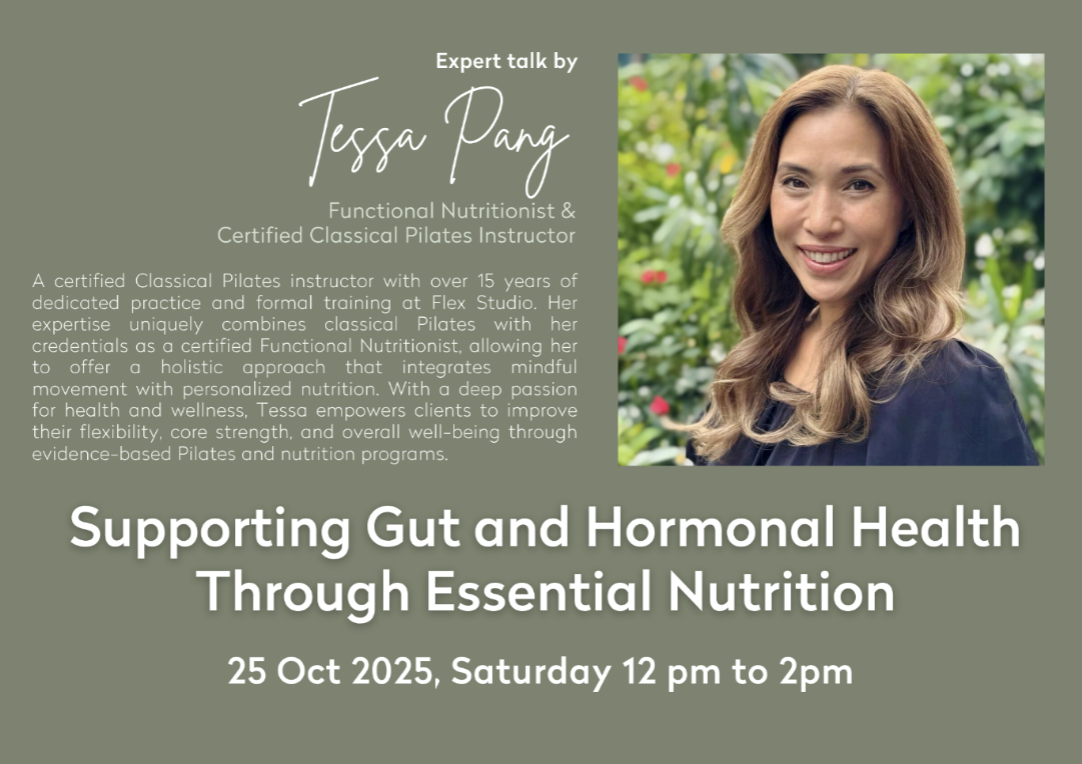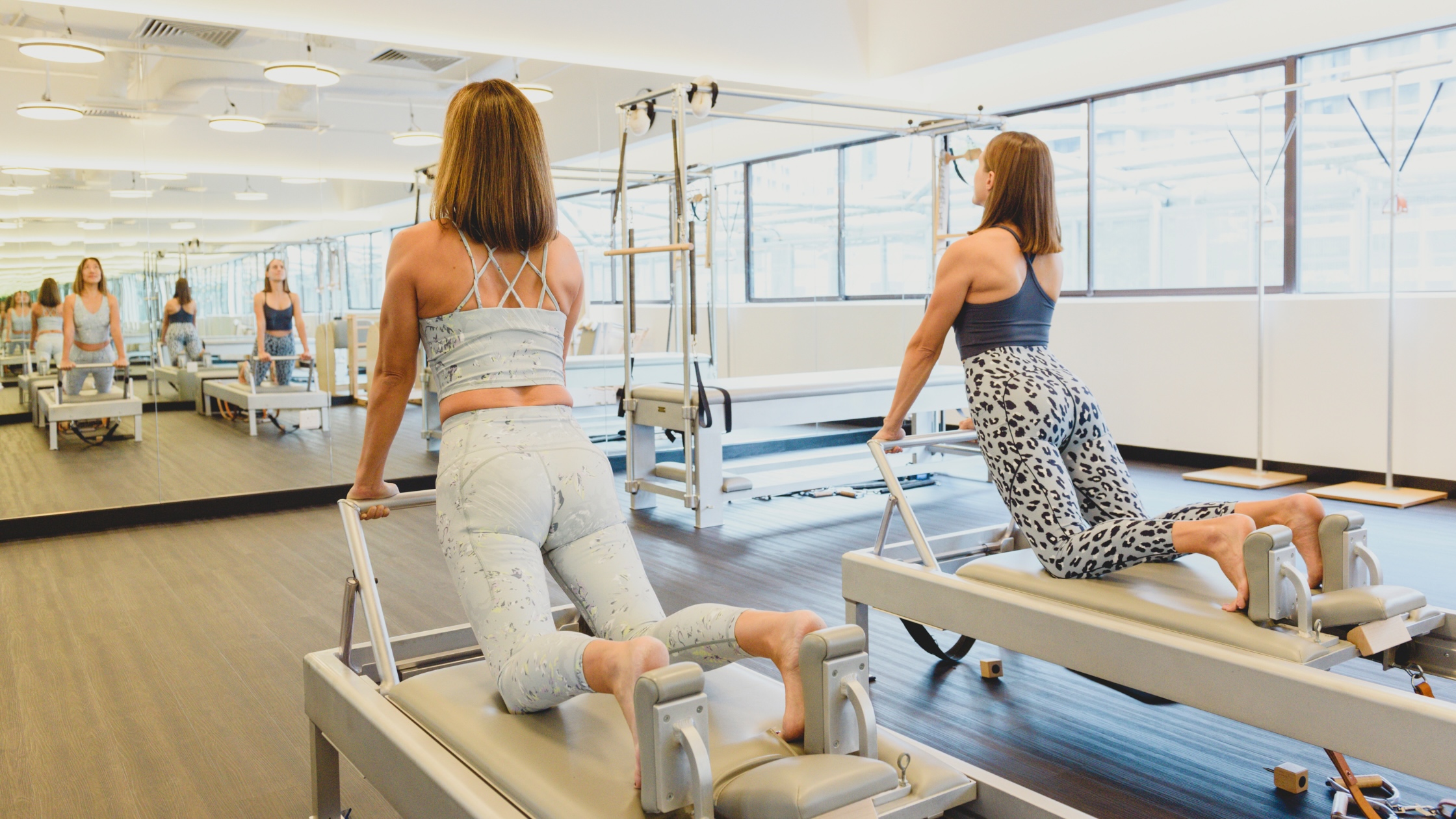Women’s health constantly evolves through the menstrual cycle, perimenopause, and menopause, each bringing hormonal shifts that affect mood, energy, digestion, and sleep. Instead of resisting these changes, cycle syncing encourages aligning exercise, nutrition, and lifestyle with the body’s rhythms. Functional Nutritionist and Flex Studio Classical Pilates Instructor Tessa Pang shares how syncing Pilates with your cycle can support lasting health.
Flex: How can Pilates and functional movement support women in perimenopause or menopause compared to high-intensity training?
Tessa: High-intensity workouts are fast and demanding but, during perimenopause or menopause, too much intensity without proper progression can increase cortisol and oxidative stress, which may speed up aging.
Pilates, in contrast, builds lifelong fitness by improving strength, posture, and flexibility through its six core principles, while also reducing injury risk and enhancing mind-body connection.
For long-term health, Classical Pilates stands out. Studies show it supports sleep, balance, mobility, cognition, and heart health, making it a sustainable practice at any age.
Flex: What is cycle syncing, and why is it gaining popularity?
Tessa: Cycle syncing means adapting routines like diet, exercise, and daily activities to the four phases of the menstrual cycle: menstruation, follicular, ovulation, and luteal. By tuning into hormonal rhythms, women can work with their bodies rather than against them, often experiencing better energy, mood, and overall wellbeing.
Cycle syncing isn’t a rigid rulebook—it’s a flexible guide to help women find and honour their unique needs at every cycle phase. Athletes and non-athletes alike can benefit by noticing patterns and personalizing self-care to cultivate greater resilience, confidence, and long-term health. Recording how energy, mood, and performance change through the month helps create a truly supportive routine, especially as hormones fluctuate further during perimenopause and menopause.
Flex: How might women adapt their Pilates practice or workout intensity depending on the phase of their cycle?
Tessa: there are a few key phases of an average 28-day cycle. (Cycles can also be as short as 20 days or as long as 45 days for some females.)
The Follicular Phase (Day 1–14, beginning with menstruation)
- Menstrual phase energy is lowest; focus on gentle, restorative activities.
- Recommended exercises: stretching, stability, strength exercises, yoga, walking, swimming, Tai chi.
- Focus on nourishing foods rich in iron (beans, greens, lean meat) and vitamin C (berries, citrus, tomatoes) to boost absorption.
- As energy rises post-menstruation, gradually incorporate more creative and progressive Pilates flows with high-protein, healthy fats, and high-fiber carbs.
- During menstruation, avoid high-intensity workouts; opt for low-impact activities instead.
- Exercise can alleviate symptoms like cramps, bloating, and mood swings, and boost energy and overall wellbeing.
- Listen to the body and adjust intensity, frequency, and type of exercise accordingly.
The Ovulation Phase (around Day 14)
- Ovulation brings peak energy – ideal for advanced Pilates or strength training.
- Eat cruciferous vegetables like broccoli and kale during ovulation.
- These veggies support liver detox and help balance estrogen levels.
This fuels the body to take advantage of high energy phases safely and effectively.
The Luteal Phase (Day 15–28)
- As hormone levels drop, energy decreases.
- Pilates practice should shift to gentler, restorative sessions focusing on stability.
- Nutrition emphasis on lean proteins, complex carbs, and magnesium-rich foods.
- Magnesium-rich foods include dark leafy greens, nuts, seeds, and dark chocolate.
- Whole-food mindful treats can curb cravings without causing energy crashes like processed snacks do.
Beyond the Cycle: Supporting Long-Term Wellness
While cycle syncing addresses the monthly rhythm, Pilates also supports women through the broader hormonal transitions of perimenopause and menopause. Pilates builds a foundation for sustainable strength and mobility, improving sleep, balance, bone density, and even cognitive health, all critical as hormones fluctuate later in life.
Breathwork and mindfulness are also central. “Joseph Pilates believed breathing was an ‘internal shower’ for the body,” Tessa explains. Breath practices calm the nervous system, reduce stress hormones, and directly improve digestion and sleep, two areas often affected by hormonal changes.
The Takeaway
Classical Pilates is more than a workout. It’s a way to move in rhythm with your body. By adjusting intensity through the menstrual cycle and integrating nutrition, mindfulness, and recovery, women can feel stronger, calmer, and more connected at every stage of life.
Join Tessa on 25 October 2025 at Flex Studio Singapore to learn how to support your gut and hormonal health through essential nutrition. Grab your spot now!

ORCHARD
390 ORCHARD ROAD, PALAIS RENAISSANCE #05-02 S238871
WhatsApp +65 9016 3539

